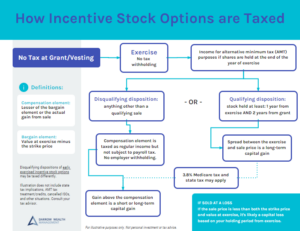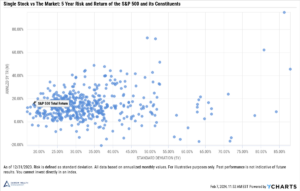Updated for 2024. When you sell incentive stock options, it’s considered a qualifying or disqualifying disposition depending on your holding period. If you don’t sell ISOs by the end of the calendar year of exercise, it can trigger the alternative minimum tax. Further, your employer isn’t required to withhold for taxes at exercise or sale. There are tax benefits when meeting the criteria for a qualifying sale of ISOs. But there are also risks. Here’s how incentive stock options are taxed.
If you have ISOs, work with your financial and tax advisor on tax planning strategies for your stock options. Managing equity compensation requires proper planning to avoid unwanted surprises.
How incentive stock options (ISOs) are taxed
There is no tax due at grant, vesting, or exercise of incentive stock options. If you sell stock options for a gain, tax will be due the year in which the ISOs were sold. Your employer will not withhold taxes upon sale of the stock. You will want to coordinate your plans with your financial advisor and CPA prior to selling your stock options.
Tax treatment of incentive stock options at sale
When you sell ISOs, it’s considered either a qualifying or disqualifying disposition depending on how long you held the stock. If you meet the requirements for a qualifying disposition, you can benefit from tax savings, all else equal. The minimum holding period for a qualifying sale of incentive stock options is: 2 years from the grant date and 1 year after exercise. Everything else is a disqualifying disposition.
In addition to federal income tax and/or capital gains tax you may also need to pay tax at the state level.
Benefits of a qualifying disposition of incentive stock options
A qualifying disposition generally means you’ll only pay long-term capital gains tax on the gain. For tax purposes, the gain is typically the sale price minus the strike price multiplied by the number of shares sold. Given that long-term capital gains rates are the most favorable, this can save considerably on your tax due.
Holding onto stock long enough to qualify for favorable tax treatment can mean paying less in tax. But there’s also the risk that the stock declines in value and you’re left with less or perhaps even a loss. Don’t let the tax-tail wag the dog.
If you don’t meet the ISO holding requirements, you have a disqualifying disposition
A disqualifying disposition happens when incentive stock options are sold too early to meet the ‘qualifying’ holding period. If you exercise and hold the shares, the disqualifying disposition is typically taxed as ordinary income and capital gains. The difference between the fair market value at exercise and the strike price is taxed as regular income. It is not subject to payroll taxes. Obviously, if your shares are underwater or you have a loss, the rules are different.
Short-term capital gains apply if you hold the stock for less than a year before selling. If you keep the stock for more than a year, it’s a long-term capital gain. Capital gains are generally calculated as the difference between the price you sold the stock for and the value at exercise. In another words, your capital gain is any subsequent gain after exercising the stock options, but if you exercise and sell the stock right away, you shouldn’t have a capital gain to report.
Disqualifying disposition tax a high level:
- If the sale price is greater than the value at exercise and the strike price, the bargain element is taxable as ordinary income. The additional gain between the value at exercise and the sale price is a capital gain (short or long-term depending on your holding period after exercise).
- If the sale price is less than the value at exercise, but above the strike price, the compensation element will be the actual gain on the sale (lower than the bargain element).
- If the sale price is less than the strike price, you’ll likely have a capital loss.
Alternative minimum tax (AMT) considerations
Exercising incentive stock options could have indirect tax implications. If the stock isn’t sold before the end of the calendar year, it could trigger the alternative minimum tax. The AMT is a parallel tax calculation. Essentially, it means you’re prepaying tax. In years when you are subject to the AMT, certain tax deductions may be disallowed, resulting in additional taxes. In years when you aren’t subject to the AMT, you can get an AMT credit (essentially a refund of prepaid tax).
Again, you’ll want to work with your accountant in advance to run the numbers. Some states, including California, also have their own alternative minimum tax too.
6 Tax Strategies for Incentive Stock Options and AMT
Other considerations for ISOs
The taxation of stock options can change depending on how stock options are treated during a merger or acquisition or if you early-exercised your options. Liquidity issues can become a real factor, especially for employees at later stage private companies. Before an IPO, you’ll also want to make decisions about whether to exercise or wait for liquidity. And if you plan to leave the company, find out how long you’ll have to exercise your vested shares before you lose them.
When stock-based compensation is significant, it’s important to work with an advisor who specializes in the space.
To learn more about how Darrow may be able to help you manage your stock options, schedule a call with an advisor today.











